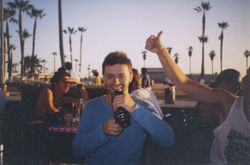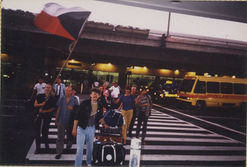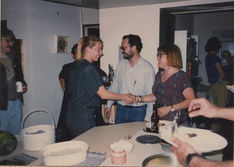1989: Dialogue Prague/Los Angeles.

Program.
Dialog: Prague/Los Angeles began as an idea between two women: Barbara Benish (USA) and Zdenka Gabalová (CZ).
They had a vision to start a conversation through art that would bridge the two countries- in the years before the Velvet Revolution was even imagined.
Benish was searching for ways to expand traditional exhibition practices as an artist, which in California in the 1980's had hit a market high. She bonded with the artists in Prague and Brno working in the parallel structures and showing their art in the hops fields and courtya of Prague.
In Czechoslovakia the parallel systems' art scene was thriving; presenting a cultural phenomenon in the otherwise repressive totalitarian regime that had kept the borders closed to the west for nearly 40 years.



The exchange took nearly three years of planning, smuggled letters and coded messages, fundraising, maxed out credit cards, and diplomatic negotiations in order to make the vision a reality.
More than just an exhibition; it would be a cultural exchange, an experiment in soft diplomacy, and a challenge to the suffocating regimes in the Soviet Bloc.



.jpeg)
Without financial backing from either government, the two women solidified the framework for an
art exchange between Czech and American artists to take place in Prague, Czechoslovakia in the summer of 1989.
The U.S. artists arrived in Czechoslovakia, a country none of them would have imagined entering prior. They visited the studio of Aleš Veselý and each American artist stayed with a different Czech artist. They had access to their studios and shared their dwellings. In this interaction came collaborations, and the sharing of the two cultures. One of the many dialogues that this project created.
 |  |  |
|---|---|---|
 |  |  |
 |  |  |
 |  |  |
 |  |  |
 |  |  |
 |  |  |
 |  |  |
 |  |  |
 |  |
The Czech and American artists exhibited together at three different locations in Prague: Galerie Mladých, Lidový Dům, and Gong Galerie.
The exhibitions proceeded the fall of the Berlin wall by three months. During this tumultuous time, secret service surrounded the opening at Lidovy Dum in Praha and Gong Gallery where a symposium was held.
To document this monumental cultural event STB (the regime´s secret police) cameras filmed all artists and the 1000 people that streamed into Prague from villages across the country to see the show.
This gathering of the Czechoslovak public and the 27 artists joined together to defy the regime. It was a small turning point in a summer of many.
Artists.
USA:
-
Kim Abeles
-
Dawn Arrowsmith
-
Barbara Benish
-
Mark Cervenka
-
Habib Kheradyar
-
Robert Kingston
-
Deborah Lawrence
-
Karl Matson
-
Leland Means
-
Christian Mounger
-
Andrea Nadell
-
Kirk Phillips
-
Jeffrey Vallance
-
Jim Uyekawa
-
David Wells
CZ:
-
Michael Blažek
-
Tomáš Císařovský
-
Jiří David
-
Stanislav Diviš
-
Ivan Kafka
-
Vladimír Kokolia
-
Jan Merta
-
Vladimír Merta
-
Stefan Milkov
-
Tomáš Ruller
-
Margita Titlová-Ylovsky
-
Josef Žáček
Lidový Dům
 |  |  |  |
|---|---|---|---|
 |  |  |  |
 |  |  |  |
 |  |  |  |
 |  |  |  |
 |  |  |  |
 |  |  |  |
 |  |  |  |
 |  |  |  |
 |  |  |  |
 |  |  |  |
 |  |  |  |
 |  |  |  |
 |  |  |  |
 |  |  |
Galerie Mladých
 |  |  |  |
|---|---|---|---|
 |  |  |  |
 |  |  |  |
 |  |  |  |
Gong Gallery
 |  |  |  |
|---|---|---|---|
 |  |  |  |
 |  |  |  |
 |  |  |  |
 |  |  |  |
 |  |  |  |
 |  |  |  |
 |  |  |  |
 |  |  |  |
 |  |  |
Part II
By 1990, the world knew where Prague was as the "Velvet Revolution" had become popular in the international press for the peaceful political changes and the eloquent president who was able to translate the meaning of freedom into inspiring words.
With the support of president Václav Havel, Jane Fonda, Jan Urban, Ivan Gabal, Madeline Albright, Max Protetch, Karel Babíček, Otis/Parsons Art Institute, the New School in New York City, and several galleries in Los Angeles, and after a fundraising show at Barnsdall theater in L.A., the 12 Czechoslovak artists were brought to Los Angeles in 1990 to show and fulfill the dream of a true exchange.
The phenomenal success of the exchange not only solidified life-long friendships since the artists stayed in one another's homes, ate and drank together, made art and music and danced, but set a standard for what cultural exchange means in the new millennium.
The arrival of Californians to the grey and intimidating Communist Czechoslovakia at that time was a milestone, but perhaps even more phenomenal was the arrival of the Czechoslovaks to Los Angeles international airport in the summer of 1990, many of them having passports for the first time.
While in LA the artists exhibited at Otis Parsons gallery, the Santa Monica Museum of Art, and Arroyo arts collective.
They also exhibited their monotype prints from a workshop with David Wells at the Idyllwild school of music and art.

Otis Parsons Gallery
 |  |  |
|---|---|---|
 |  |  |
 |  |  |
 |  |  |
 |  |  |
 |  |  |
 |  |  |
 |  |  |
 |  |  |
 |  |  |
 |  |  |
 |  |
Arroyo Gallery
 |  |  |  |
|---|---|---|---|
 |  |  |  |
 |  |  |  |
 |  |  |  |
 |  |  |  |
 |  |  |  |
 |  |  |  |
 |
Santa Monica Gallery
 |  |  |  |
|---|---|---|---|
 |  |  |  |
 |  |  |  |
 |
Idyllwild
 |  |  |
|---|---|---|
 |  |  |
 |  |
While the art itself was a visual catalyst to exchange goods ie. culture, it was the respective political and social environment that was truly changed. In what we today call "social practice", the artists were immersed in one another's lives, each living for two weeks with their assigned home-artist, creating pseudo art families that immersed themselves in the other's culture over the two year period. Besides the lasting friendships that grew, the art itself came to understand and express what freedom is.
The euphoria of that first summer was palpable, as the defiant artists stood their ground against the regime.
The experience the Americans brought back with them from Prague was indeed about community and transformation of the polis via the arts. How to install land art in a hops field, DIY openings in barns before the police closed it down, hand-printed invitations that circulated in a tightly run parallel structure subversive to dominant authorities–all this informed how those artists would approach their own cultural production in the future and back home.
And for the Czechs and Moravians who swam in the Pacific ocean for the first time, many were able to sell their art and afford things unknown until then. Others went on to have more international recognition showing at P.s.1 Museum in New York where Gabalova went on to be curator after the changes. In 1992, Benish was awarded a Fulbright professorship and moved to Prague, teaching at the Academy of Applied Arts in the sculpture studio of Kurt Gebaur. She stayed, and eventually the current NGO, Artdialog was officially established in Prague in 2004, a year that marked the 15-year anniversary of the original project.
Artists Work.




Artist Statements.




Part III
15th Anniversary: Certain Traces.
Dialogue Los Angeles / Prague.
2004
This is the fifteen-year commemoration of the historic Dialogue: Prague / Los Angeles show of 1989-1990 that defied Communist sanctions and presaged the final dissolution of communist Czechoslovakia. A multi-venue exhibition taking place in Los Angeles and Prague, Certain Traces celebrates the achievement of the original project, as it extends the original concept to explore the meaning of creative discourse for a diverse group of artists from Los Angeles and Prague in a newly defined open society. In 1989 twelve Czech artists risked official sanction to take part in an artist exchange with twelve Los Angeles counterparts. Dialogue opened just three months prior to the massive public demonstrations in Prague that set off the final collapse of communism. The exhibition attracted hundreds of visitors daily and was later proclaimed a harbinger of change and a “miracle of free expression.”
Fifteen years have brought significant change to the political and cultural landscape in both countries, yet the basic notion that inspired the first exhibition—that a creative discourse in the arts might rise above national borders to promote artistic innovation, mutual understanding, and amity—remains unchanged. This is the point of departure for Certain Traces: Dialogue Los Angeles / Prague 2004.
The artists at other venues include: Kim Abeles (USA), Lynn Aldrich (USA), Deborah Aschheim (USA), Barbara Benish (USA/CZ), Erika Bornová (CZ), Jiri Cernicky (CZ), Tomas Cisarovsky (CZ), Habib Kheradyar (USA), Jan Jakub Kotik (USA/CZ), Alena Kotzmannova (CZ), Karl Matson (USA +), Leland Means (USA), Jan Merta (CZ), Vladimir Merta (CZ), Christian Mounger (USA), Petr Nikl (CZ), Tomas Ruller (CZ), Štepánka Šimlová (CZ), Margita Titlova (CZ), Marnie Weber (USA), Alexis Weidig (USA), and Liz Young (USA).
Other venues in the Los Angeles area include: Los Angeles Municipal Art Gallery; Post Gallery; Sam Francis Gallery, Crossroads School; Czech Front Gallery; and S.C.A.P.E., Corona del Mar. Organized by Barbara Benish with curator Sarah Brock in Prague, the exhibition will open in November 2004 in Prague.
Gallery
Part IV




1989 Dialogue
Prague/Los Angeles.
30th Anniversary
Celebrating 1989 and the 30-year anniversary of ArtDialog at the DOX Centre of Contemporary Art in Prague.
The exhibition showcased original photos, documents, video, audio, and more from the art exchange between 15 American and 12 Czech artists which was a milestone in it's time.
Prior to 1989, the Czechoslovakian regime banned any contemporary art that did not support their dogma. This slowly changed in the late 80’s as artists pushed the authorities with clandestine exhibits and increasingly challenging work in the streets and hops fields across the country. By July of that summer, Dialog: Praha/Los Angeles opened its doors to the public. The exhibitions in Prague brought thousands of people to the galleries at Lidovy Dum and Mladych, creating a crack in the regime’s hostility towards the West.
The Velvet Revolution came just a few months later, led by artists and intellectuals. It demonstrated the importance of the arts and turned former dissident and writer, Vaclav Havel into the new president of Czechoslovakia.
This was a formative point in history and we are excited to share with you where it all started and acknowledge how far we have come, as a small arts organization in Central Europe...
Gallery





























